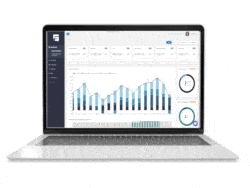In the first three parts of this series, we discussed the advantages of using both QuickBooks and commercial real estate software to maximize your success as a property owner or investor. In this article, we’ll take that concept a step further to look at the spot where property management and accounting overlap: strategic asset management.
Keep reading to learn what strategic asset management is, its main purpose, and some practical tips to improve your own asset management using CRE software and QuickBooks.
What is Strategic Asset Management?
In commercial real estate, strategic asset management is a complex job that aims to lower risk and raise revenue for a property or portfolio. It involves analyzing many aspects of property operations, including purchasing, income, maintenance costs, risk assessment, market factors, and future sale of the asset.
Essentially, strategic asset management means looking at the big picture of how a property runs and how it fits into the investor’s goals.
What is the Difference Between Asset Management and Property Management?
While asset management and property management can overlap, there are some notable differences between the two roles. Property managers generally handle day-to-day operations on site. Responsibilities usually include invoicing and collecting rent and other payments, solving tenant issues, and coordinating maintenance and upkeep.
Asset managers, on the other hand, tend to focus on tasks like tax and budget issues and maintaining financial compliance. They also meet with investors and organize the purchase and sale of properties.
Notably, successful portfolios employ property managers and asset managers that work together to notice and solve problems. For example, they might collaborate to decide on a capital improvement project to increase revenue on a property.
What are the Main Goals of Strategic Asset Management?
Strategic asset management has two goals: lower risk and increase revenue. These can be achieved in a variety of ways. Some of the most common include:
- Property improvements: fixing, updating, and modernizing assets to make them more useful and appealing can raise revenue and reduce risk of accidents. Good examples are renovating common spaces, cleaning up landscaping, or switching to eco-friendly technology. It also means staying on top of regular maintenance
- Building revenue sources: this includes staying up-to-date on rent and lease escalation rates to avoid falling behind. It may also mean adding extra income sources like parking or amenities.
- Cost reduction: using efficient technology for utilities and operations saves time, resources, and money. Closely monitoring budgeted and actual expenses makes it easy to spot and fix spending issues.
- Portfolio building: Asset managers do not usually focus on a single property. They help investors choose smart, varied assets for a strong portfolio. Diverse portfolios avoid risk by not depending on a single location or industry for success.
What are the Phases of Asset Management?
There are three main phases of asset management to cover the cycle of owning a property. Each phase has different strategies and goals, but all aim to maximize the property’s overall returns.
Acquisition
Asset managers help perform due diligence when investors are considering a property. Then, after purchase, they design and outline a financial plan to create the best outcome.
Holding
During the holding phase, asset managers keep a close eye on a property’s financial performance metrics. Together with property managers, they help address any issues and develop growth strategies. This may include improvement projects or budget adjustments to increase revenue and decrease expenses.
Disposition
A crucial responsibility for asset managers is planning a good exit strategy for each property. This means working with investors to determine if, when, and how assets should be sold for maximum value. It also includes deciding where to reinvest any sale profits for the health of the portfolio overall.
Important Financial Metrics for Asset Managers
Asset managers track many financial metrics and indicators for each property they oversee. Using multiple metrics is important to gain a full picture of a property or portfolio’s financial health. It also helps narrow down the source of any issues. Some of the most important financial metrics for asset managers include:
- Net operating income (NOI)
- Return on investment (ROI)
- Debt service coverage ratio (DSCR)
- Occupancy rates
- Certificate of insurance (COI) compliance
How STRATAFOLIO Simplifies Strategic Asset Management
STRATAFOLIO is an invaluable tool for asset managers. It combines property management functions with the accounting functions of QuickBooks. This means STRATAFOLIO allows asset managers, owners, and investors to see all of the information they need to plan for the future in one convenient location.
Asset managers can calculate and track the key metrics mentioned above directly in STRATAFOLIO. Customizable reports also allow asset managers to dig deep into the details of a single property or take a step back and see the portfolio-wide picture. An investor portal makes it easy to share these reports and insights. Plus, a two-way integration with QuickBooks means that financial data is always accurate, updated, and ready for analysis.
To learn more about STRATAFOLIO’s strategic asset management solution, schedule a free demo now.






